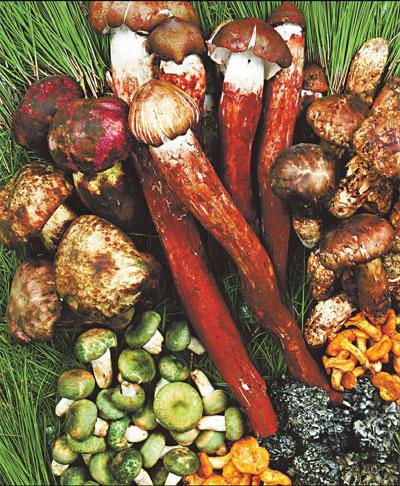|
A variety of wild mushrooms offer a feast for the taste buds. (Photo: China Daily) |
BEIJING, July 24 (Xinhuanet) -- July is one of the best months to tickle your palate with fresh wild mushrooms. For Beijing gourmands the good news is that restaurants here are transporting fresh mushrooms by air to the capital daily. Colorful Yunnan, for example, has been flying in 80 kg of wild mushrooms to its Anzhen branch, and 100 kg to its Temple of the Moon branch since last week. In & Out, a popular Yunnan cuisine restaurant located at Sanlitun has also been flying in fungi.
The fresh fungi taste much stronger, slippery, and far more savory, than refrigerated, dried, or canned mushrooms.
Yunnan province in Southwest China produces probably the world's biggest variety of fungi - more than 800 kinds and the province alone consumed 50,000 tons of wild fungi last year.
A recent media tasting at Colorful Yunnan allowed us to take a look, and have a taste of some newly arrived mushrooms from the region.
Matsutake, dubbed "king of fungi", is probably the most famous fungus in Yunnan. Interestingly, the locals didn't eat it much until the Japanese started to import it in large quantities in the mid-1980s, according to Wang Min, general manager at Colorful Yunnan.
The story goes that, matsutake were the only "plants" that survived the atomic bombing on Hiroshima in 1945, and since then the Japanese have developed a strong belief in its health benefits.
Last year, Yunnan exported 957 tons of the fungus, which can only be gathered in wild fields. Yunnan is now trying to develop the domestic market for the fungus.
Boletus and yellow morel are two other native fungi that Yunnan exports in large quantities.
"There are 158 varieties of boletus, but only a few varieties, the yellow, white and black ones, are edible," Wang says. "A trick is to fry garlic slices with boletus. If the garlic slices turn black, then the boletus is not edible."
Boletus is said to dispel and, prevent colds, and strengthen the immune system. Yunnan had no SARS cases in 2003, and the locals claim this was because they eat a lot of mushroom and fungus.
The king fungus in Yunnan is dry fungus, or ganbajun, an intensely fragrant, paper-thin fungus with white and black wrinkles when it's fresh. Picked in pinewoods, the fungus has a pine fragrance, and tastes a bit chewy.
Local people fry it with fresh green pepper, or put it into fried rice, or brine it and then deep-fry it with red chili and leek seeds to make a tasty sauce.
At Colorful Yunnan, one has a chance to see some other popular edible mushrooms and fungus from Yunnan. Termite mushroom has a snow-white umbrella and a long brown-reddish stem. It is often made into a sauce. A very tasty cold starter is made of the fungus, which is shredded, dried and marinated in oil.
Chicken oil fungus is a small, brightly golden fungus resembling chicken oil in color, which grows in forests. It has a pleasing fruity smell. Green head fungus loses its green color on the umbrella after it's cooked. It is believed to clear internal heat in the liver, and have anti-cancer functions.
Big-head fungus is a comparatively new fungus in the market, and is believed to replenish energy in the liver and kidneys.
Besides being fleshy, tender and slippery, fresh fungi offer a clean, sweet taste. Dry fungus has the strongest fragrance, followed by boletus, and then matsutake.
The Yunnan fungi are wild, whereas most mushrooms produced in north China, such as fragrant mushroom, flat mushroom, chicken leg mushroom, and even most tea-tree mushroom, are planted. That makes a huge difference in taste and smell.
Matsutake and boletus are also produced in north China, and morel in Sichuan, Hunan and Guizhou. But Yunnan's fungus production is superior in terms of quality and flavor, according to Liu Zonglin, executive chef at Colorful Yunnan's Temple of the Moon branch.
To retain their original taste and flavor, it is best to fry or braise fungi. But Yunnan has plenty of other cooking methods. For example, they can also be steamed in soup, in a clay pot.
Another popular method is to cook fungus with Yunnan ham to give it a meaty flavor. The umbrella of the green head fungus can be steamed with diced Yunnan ham inside. Dry fungus can be fried with shredded Yunnan ham and green bean sprouts to offer a nice contrast between chewy and crunchy textures.
Dry fungus is traditionally used in fried rice to make the simple food a tasty winner and boletus can be braised with rice to lend its strong fragrance to the food staple. Termite mushroom can be shredded and put on a pizza, according to the chef.
Colorful Yunnan has developed some unique methods of its own. In one interesting dish, matsutake and termite mushroom are grilled on a flat iron wok, to release the fragrance, but retain a sweet and slippery tasting sensation.
Finally, Colorful Yunnan has combined its fresh wild fungi with seafood. Matsutake and boletus are prepared with abalone, and Liaoning sea cucumber, as a healthy side dish to balance the otherwise very high-protein seafood.
(Source: China Daily)






